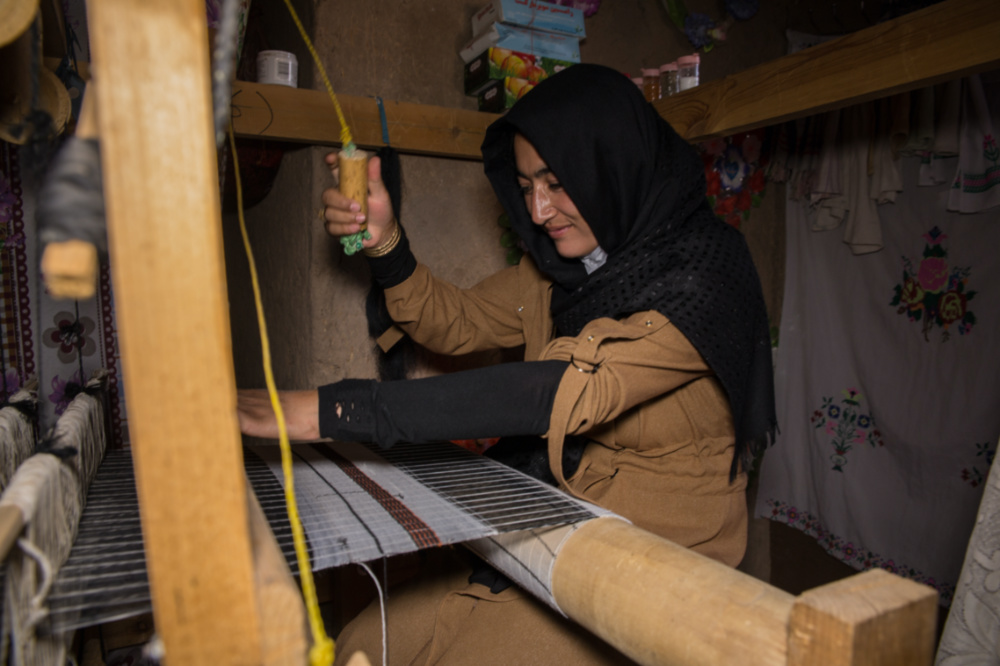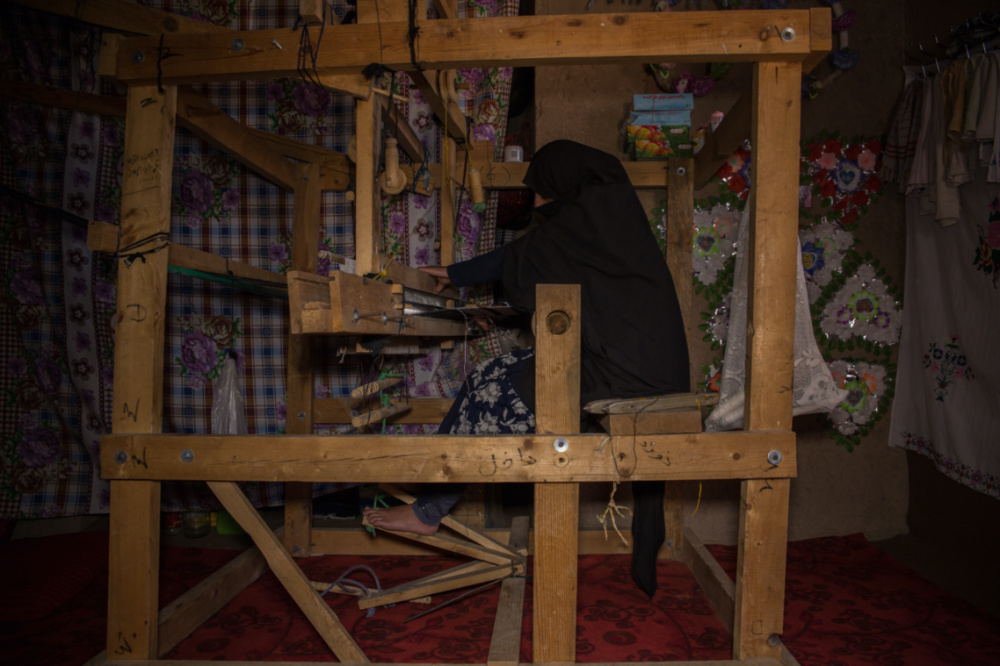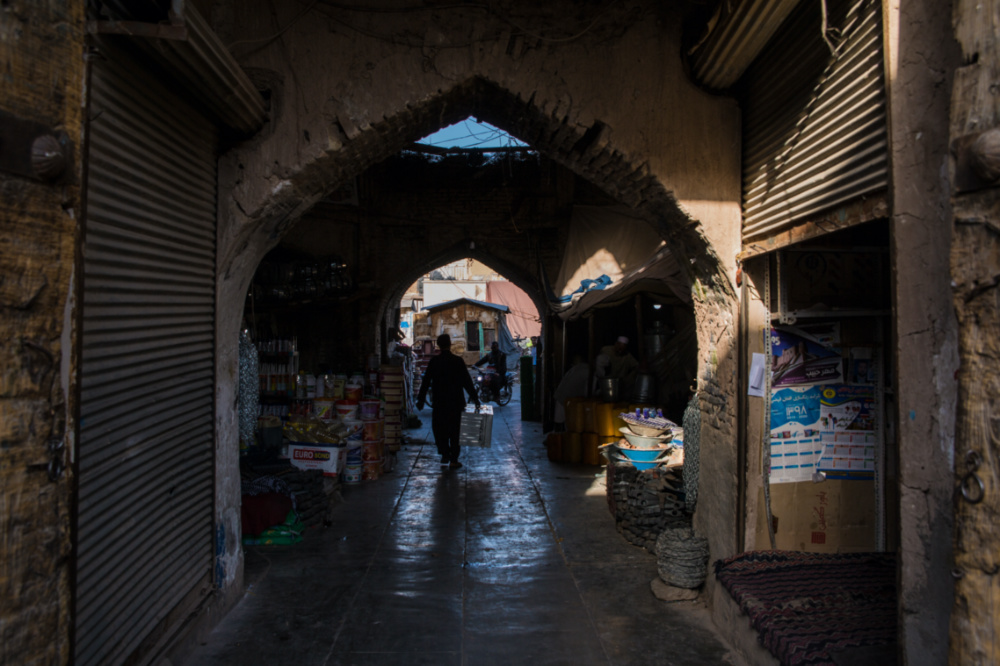
STEFANIE GLINSKI, of Thomson Reuters Foundation, reports on how Afghan women in Herat are returning to the work of silk-making…
Herat, Afghanistan
Thomson Reuters Foundation
Once an important Silk Road trading hub, the Afghan city of Herat has long been a cultural centre, but decades of war have ravaged its ancient traditional crafts.
Now thousands of women are returning to the ancient practices, seeking to revive the traditions of a city where traders once came to haggle for silk in thick-walled houses and dome-shaped bazaars offering respite from hot summers.

Mariam Sheik, 30, demonstrates on a cotton sample how she would be weaving silk in Herat, Afghanistan on 13th June. PICTURE: Thomson Reuters Foundation/Stefanie Glinski
On the outskirts of the ancient city, about 4,000 women work to cultivate silk, from raising silkworms, feeding them and harvesting their cocoons to spinning the yarn by hand – a month-long, labour-intensive process.
Mariam Sheik, 30, was given a box of 20,000 silkworm eggs by a local aid group last year and has already produced about 40 kilograms of silk, which sells at 300 Afghani ($US4) per kg.
“Our community respects and encourages the silk trade and besides that, it has helped me gain financial independence.”
– Silk-maker Mariam Sheik
“My great-grandfather was a silk-maker, so there is pride in picking up his work again,” Sheik, who lives in Herat’s Zinda Jan district, told the Thomson Reuters Foundation.
Her small village is surrounded by lush, green mulberry trees, planted years ago to feed the growing silkworms.
“Our community respects and encourages the silk trade and besides that, it has helped me gain financial independence,” she added.
Once the cocoons are dried, the processing into yarn is traditionally done by hand, although the women hope to import a machine to help speed up the process.
At the moment there is only one old spinning machine in Herat city, with not enough capacity to process them all.

Mariam Zemoni, 23, sits on her loom where she usually weaves silk into scarves in Herat, Afghanistan on 13th June. PICTURE: Thomson Reuters Foundation/Stefanie Glinski
Women have made huge strides in the conservative country since the Taliban rule of 1996 to 2001, when they were banned from attending school or work and could not even go outside without a male relative.
Growing numbers of women now complete education and work in previously male bastions, but they still face hurdles.
Four decades of war, from occupation to internal fighting, have destroyed the economy, rendering it among the poorest in the world, with few jobs – especially for young women, who occupy a particularly precarious place.
“Herat is a traditional province where few women are seen – or even allowed by their families – to work outside. That’s another reason why weaving silk is perfect for me.”
– Silk-maker Mariam Zemoni.
Many face cultural barriers and hostility not just from conservative family members, but also hardline Islamist groups, for pursuing financial independence and greater equality.
According to World Bank data, just over 20 per cent of Afghan women work, up from about 15 per cent in 2001, when the Taliban fell.
There are fears that a final withdrawal of US troops, the winding down of international engagement and the re-emergence of the Taliban may reverse gains.
“Herat is a traditional province where few women are seen – or even allowed by their families – to work outside,” said Mariam Zemoni, one of about 30 women who weave the silk into scarves and fabric.
“That’s another reason why weaving silk is perfect for me,” said the 23-year-old, who makes at least two scarves a day, selling them for 250 Afghani each.

Herat, known for its ancient crafts, has long been one of Afghanistan’s cultural centres on 16th June. PICTURE: Thomson Reuters Foundation/Stefanie Glinski
Nazir Ahmad Ghafoori, head of the Rehabilitation Association and Agriculture Development for Afghanistan which has supported the women, said 70 per cent of the cocoons were sold to Iran and Pakistan because of a lack of processing capacity.
He hopes to involve more women in Afghanistan’s silk production, expanding to provinces beyond Herat.
“The tradition is thousands of years old, and we Afghans find pride in our art and culture – and the revival of it,” he told the Thomson Reuters Foundation
Since working with the women in Zinda Jan, his organisation has set up the ethical fashion initiative, aiming to export silk produced under fair working conditions worldwide.
An executive board of 50 women in the district oversees and reports on each woman’s working condition.
Sheik, who is on the board, said the business had boosted the economy throughout the district.
Whatever silk is not exported or sold in other parts of Afghanistan makes it to Herat’s old silk bazaar, where vendors sit in small shops with high ceilings decorated with carved ornaments reminiscent of the Silk Road era.
“For the past years, our country has been known for war,” said Sheik. “It’s time the world knew Afghanistan for its arts and crafts, its culture, people – and its silk.”






